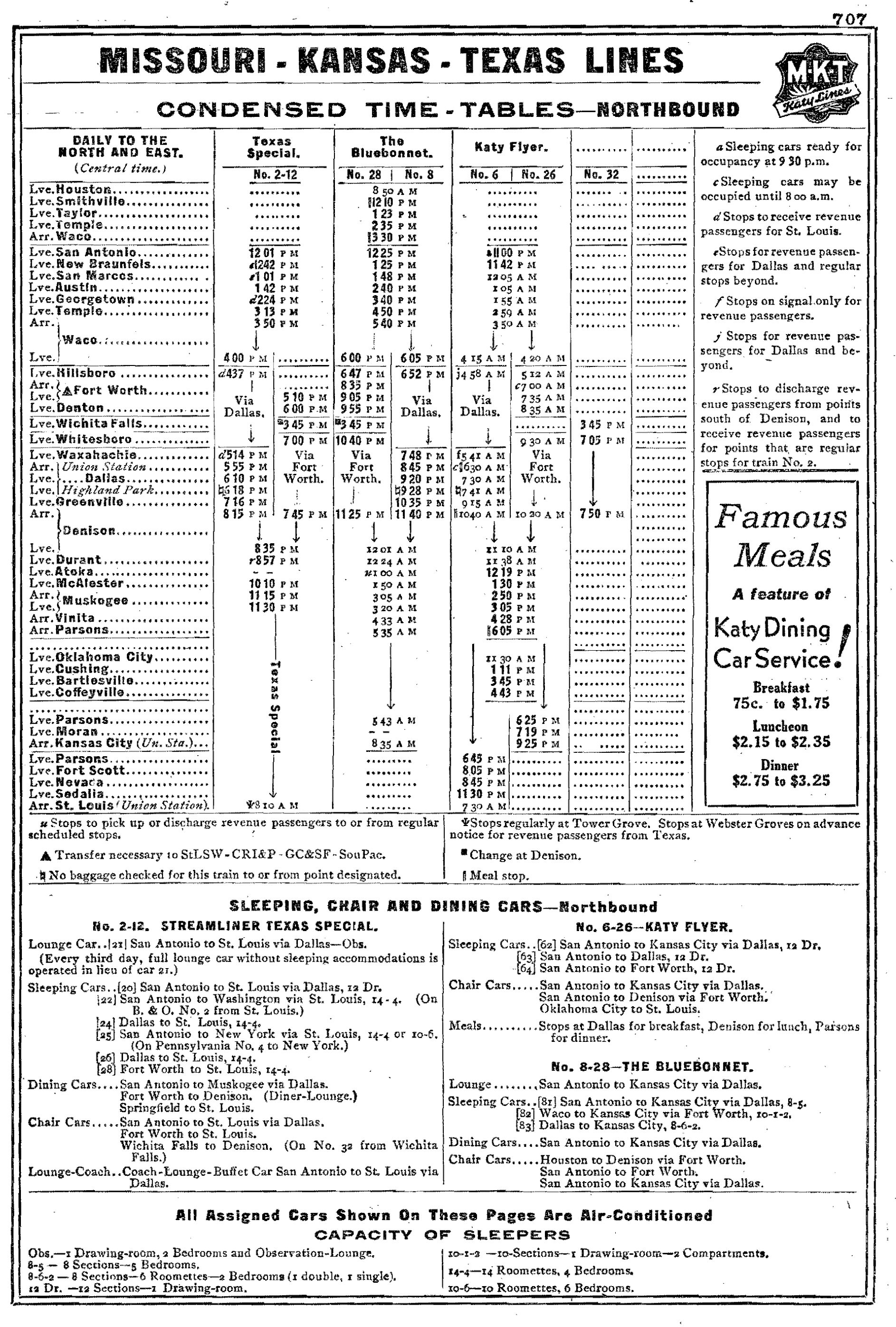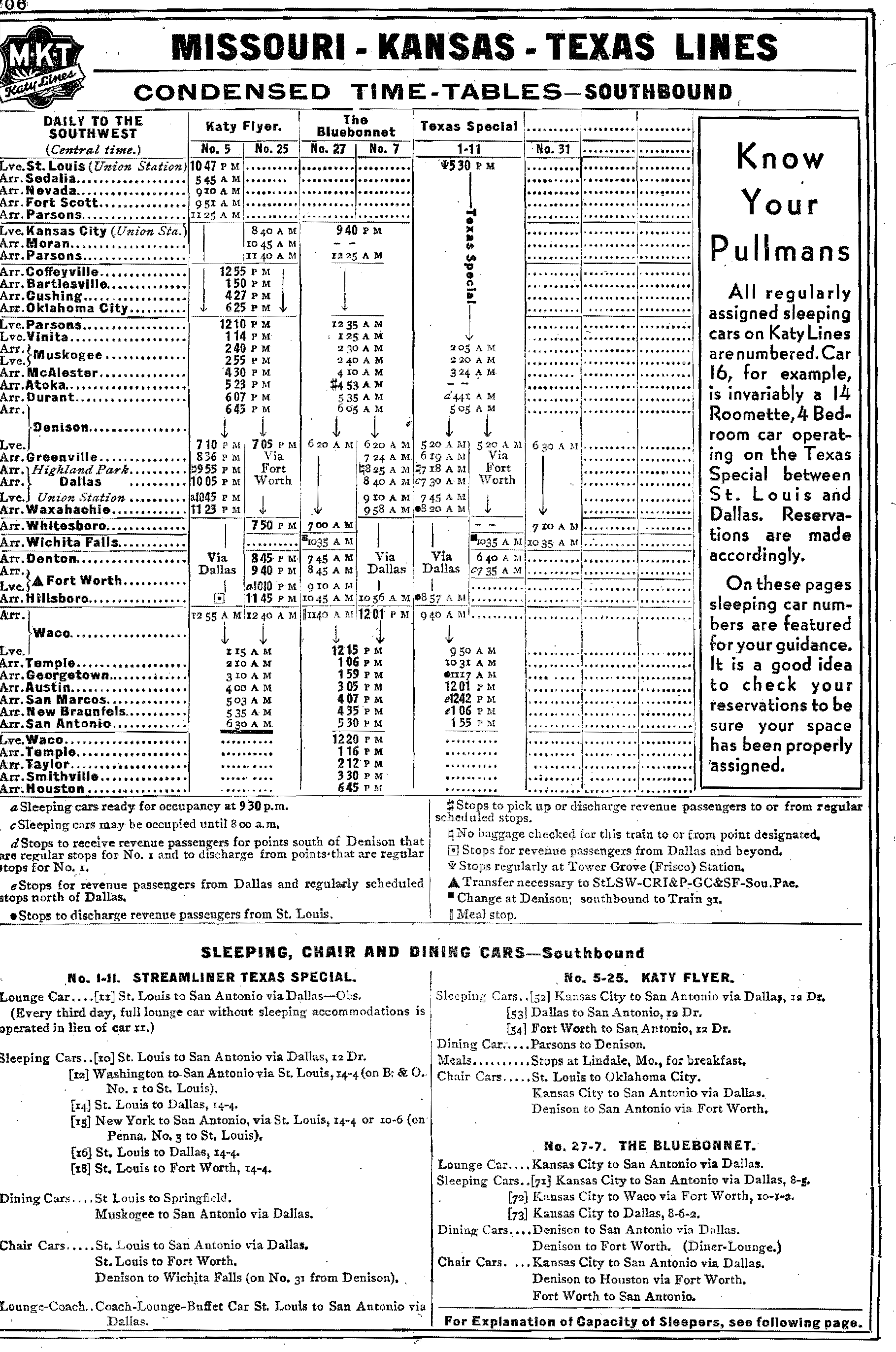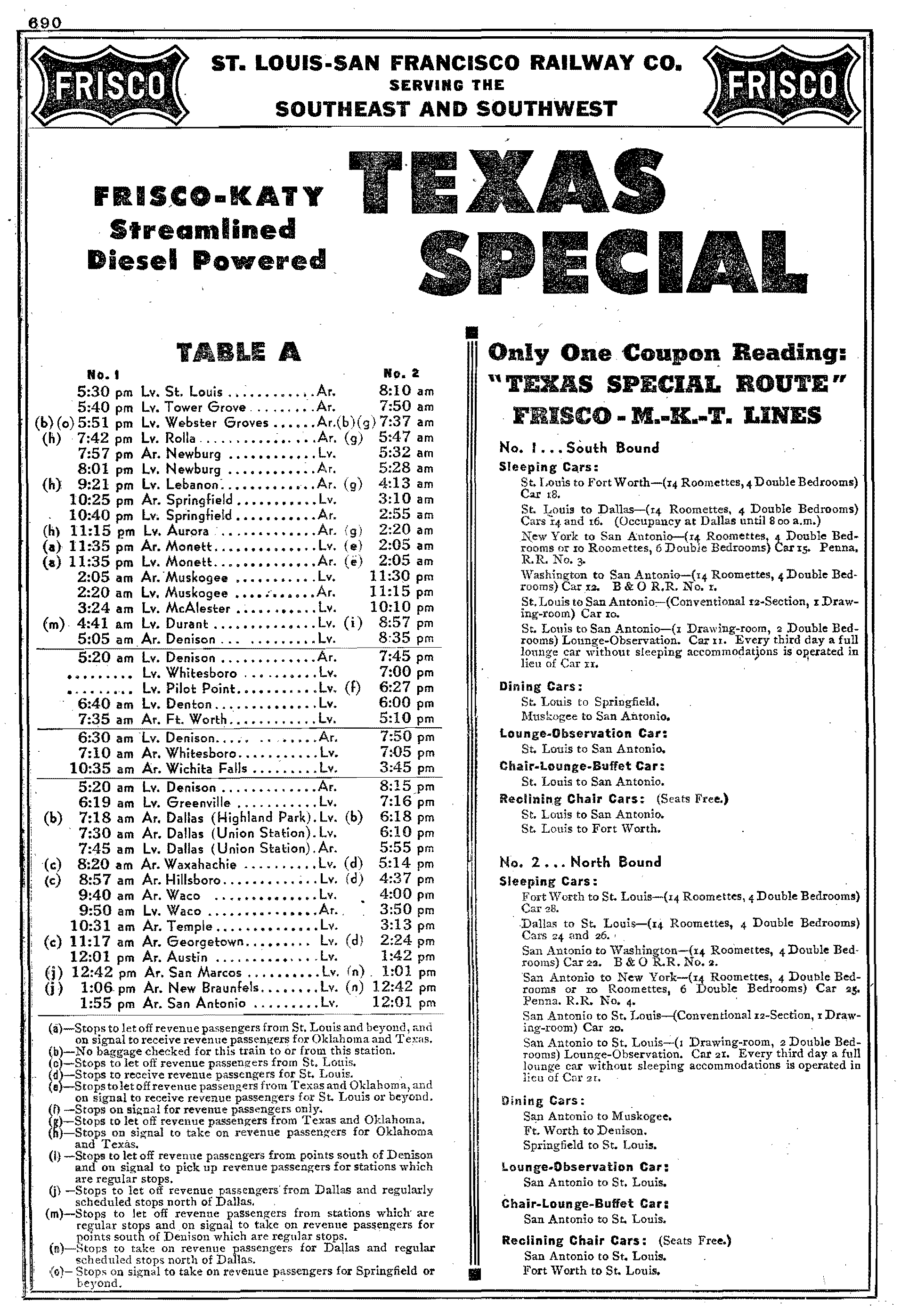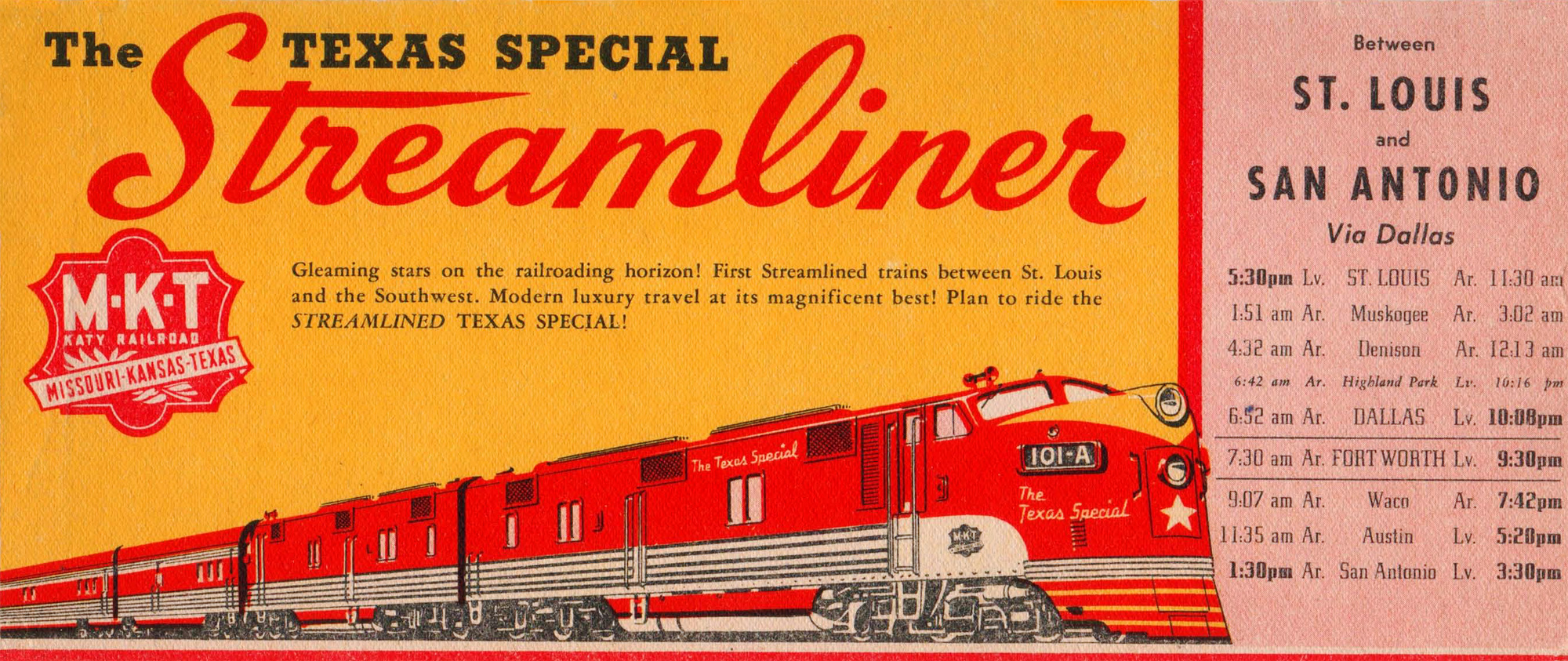"Texas Special" (Train): Route, Schedule, Consist
Last revised: February 24, 2025
By: Adam Burns
The Katy (Missouri-Kansas-Texas Railroad) and Frisco (St. Louis–San
Francisco Railway) are not well remembered for their passenger services.
However, both railroads launched a joint train that turned out to be
quite famous during the streamliner era in the late 1940s, the Texas Special.
The train featured one of the most dazzling liveries in America. For a number of years the Katy and Frisco carried a strong partnership that produced a top-quality train.
Alas, financial troubles for the Katy resulted in the service declines along its portion of the route. For a time the Frisco tolerated this setback but would eventually elect to pull out which brought an end to the Special.
The once-glamorous Special (featuring a livery of red, yellow and stainless-steel) died a slow, quiet death during the 1960s.
The Katy continued running a truncated version for a few years but finally gave up altogether. Today, nothing remains of this flashy train but its memories of those who saw and rode aboard it certainly will never be forgotten.
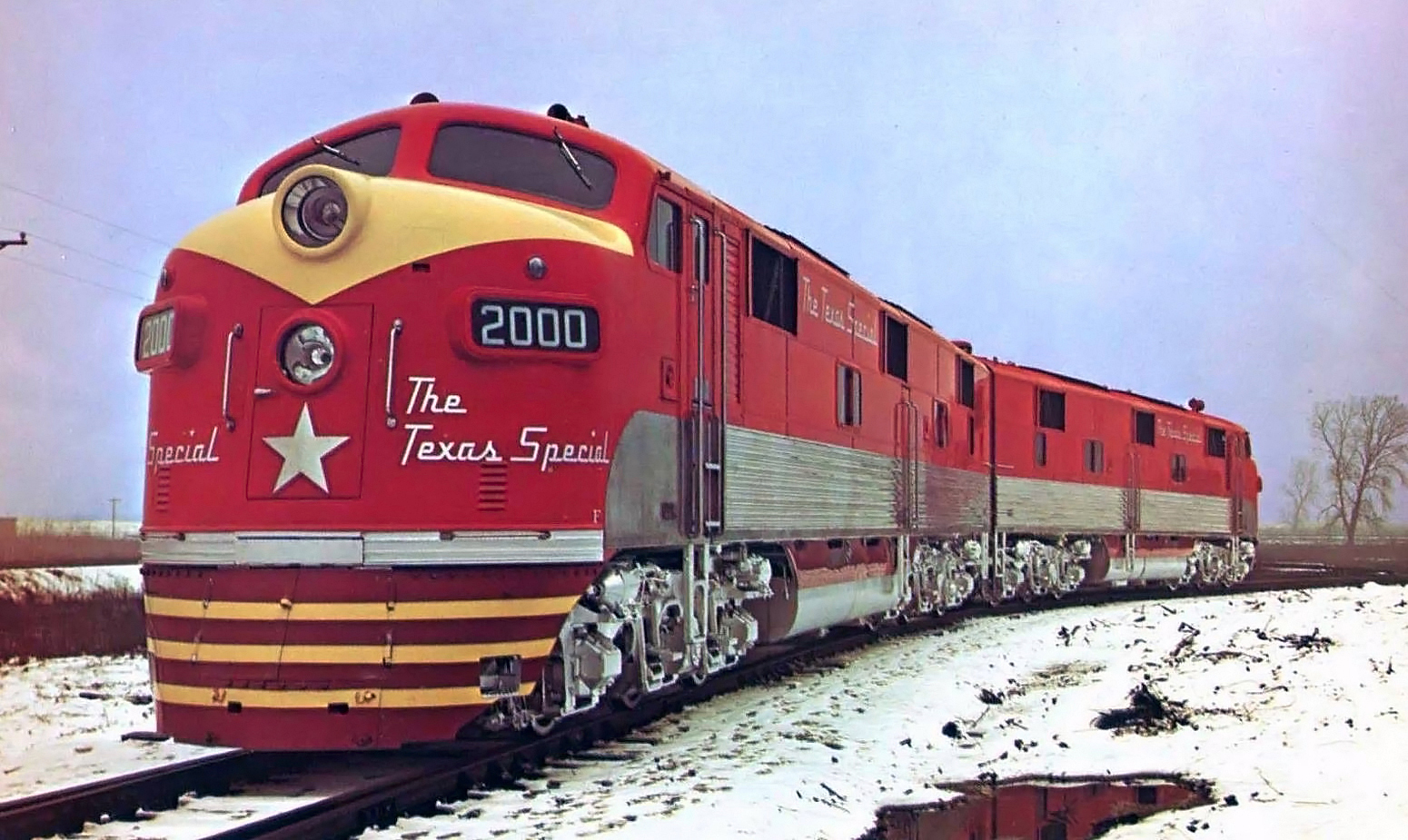 A pair of St. Louis-San Francisco Railway's ('Frisco') new E7As for the Texas Special, a streamliner operated in conjunction with the Missouri-Kansas-Texas Railroad ('Katy') in an Electro-Motive photo from March, 1947.
A pair of St. Louis-San Francisco Railway's ('Frisco') new E7As for the Texas Special, a streamliner operated in conjunction with the Missouri-Kansas-Texas Railroad ('Katy') in an Electro-Motive photo from March, 1947.Route And History
The railroads which operated the Texas Special were mid-sized Class I systems that operated in the Midwest through southern Texas.
The Missouri-Kansas-Texas Railroad like the Illinois Central and Gulf, Mobile & Ohio railroads ran, unconventionally, north-south (instead of the more common, east-west).
As its name implies, the Katy connected all of its namesake states with connections to cities such as Omaha and St. Louis in the north and Galveston and San Antonio, Texas in the south. The railroad was somewhat successful over the years but it ran into financial trouble a number of times throughout its life.
The St. Louis-San Francisco Railway, commonly known as simply the Frisco has a storied history of two halves. During the railroad’s first 60 years it had a very interesting and tumultuous history going through a number of name changes and bankruptcies (resulting in so many names).
However, after its final name as the St. Louis-San Francisco Railway, the railroad did quite well and prospered for its last 60+ years of operation before becoming part of the large Burlington Northern system in the very early 1980s.
The Special was re-inaugurated by the Katy and Frisco in May of 1948 as an all-streamlined train (it has its beginnings dating all of the way back to 1915) serving the Midwest and Southwest.
The train’s journey started on the Frisco between St. Louis and Vinita, Oklahoma where it was relayed to the Katy and carried south to various points in Texas such as Dallas/Fort Worth, Austin, Waco and San Antonio. The train also offered connecting services to Denison, Whitesboro, and Wichita Falls.
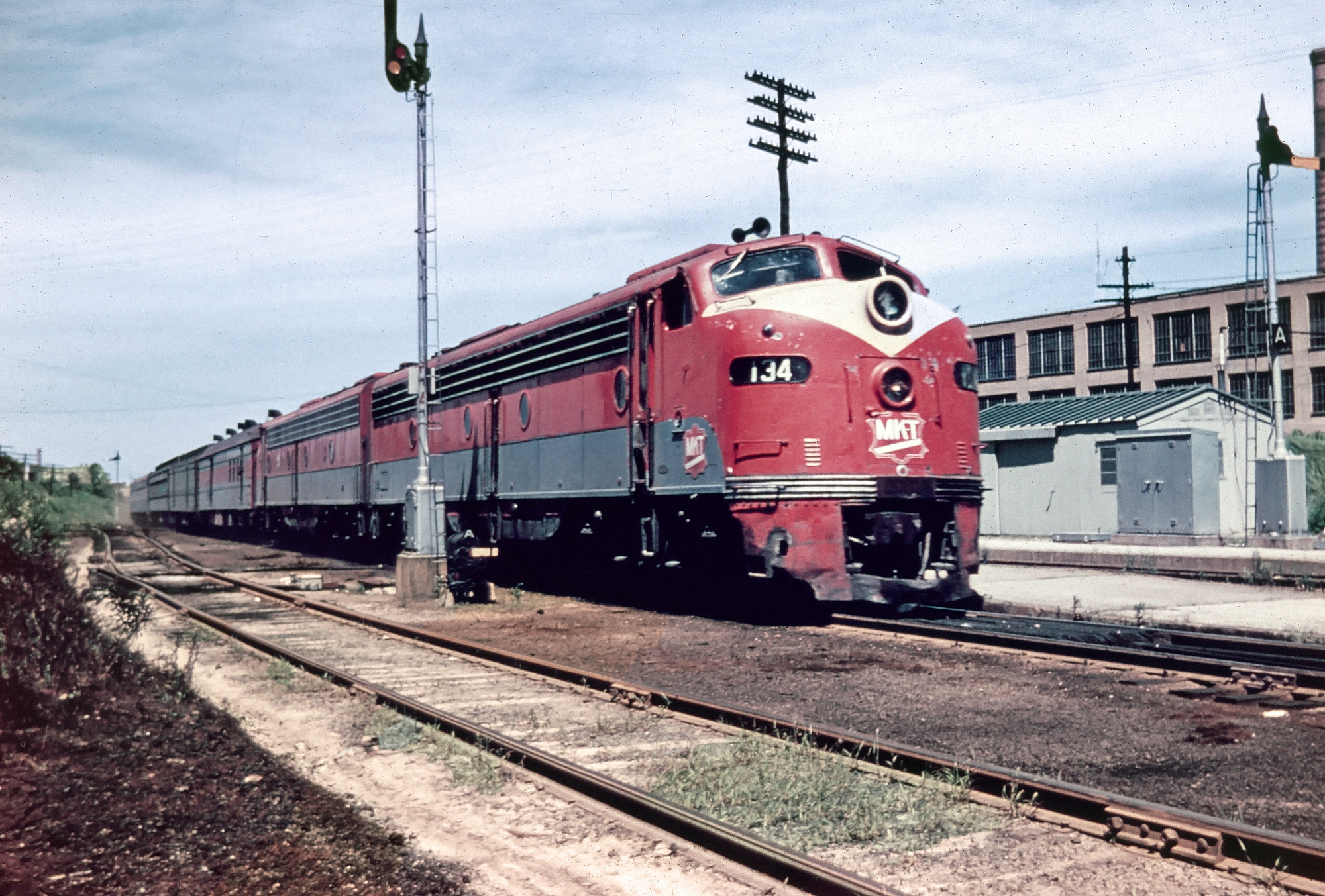 Missouri-Kansas-Texas E8A #134 arrives at Tower Grove, Missouri with train #2, the northbound "Texas Special," on the morning of June 23, 1957. Richard Neumiller photo. American-Rails.com collection.
Missouri-Kansas-Texas E8A #134 arrives at Tower Grove, Missouri with train #2, the northbound "Texas Special," on the morning of June 23, 1957. Richard Neumiller photo. American-Rails.com collection.According to the train's official timetable, once leaving St. Louis Union Station via the St. Louis-San Francisco Railway at 5:40 pm, it reached the connection with the Missouri-Kansas-Texas at Vinita, Oklahoma at 2:10 am the following morning.
From this point aboard the Katy the train traveled as far south as Denison, Texas before it split with one section heading to Fort Worth (where it arrived by 8:45 am), while the other continued southward towards San Antonino reaching that city by 2:45 pm later that same day.
Consist (1952)
Overall it took the St. Louis-San Antonino Special just over 21 hours to complete the journey while the truncated St. Louis-Fort Worth version of the train took just over 14 hours to complete its trip.
Additionally, the Texas Special through sleeper service to both Washington, D.C. via the Baltimore & Ohio as well as Philadelphia and New York City in the Northeast via the Pennsylvania Railroad. This connecting service was through the Frisco at St. Louis Union Station.
Timetable (November, 1948)
| Read Down Time/Leave (Train #1/St. Louis-San Francisco Railway) | Milepost | Location | Read Up Time/Arrive (Train #2/St. Louis-San Francisco Railway) |
|---|---|---|---|
| 5:30 PM (Dp) | 0.0 | 8:30 AM (Ar) | |
| 5:40 PM | 3.3 | 8:15 AM | |
| 10.1 | 8:03 AM | ||
| 7:43 PM | 110.7 | 6:12 AM | |
| 7:59 PM (Ar) | 119.2 | 5:58 AM (Dp) | |
| 8:03 PM (Dp) | 119.2 | 5:54 AM (Ar) | |
| 9:24 PM | 181.9 | 4:41 AM | |
| 10:30 PM (Ar) | 239.3 | 3:39 AM (Dp) | |
| 10:45 PM (Dp) | 239.3 | 3:24 AM (Ar) | |
| F 11:40 PM | 283.0 | F 2:35 AM | |
| (Ar) | 349.1 | (Dp) | |
| Time/Leave (Train #1/Missouri-Kansas-Texas Railroad) | Milepost | Location | Time/Arrive (Train #2/Missouri-Kansas-Texas Railroad) |
| (Dp) | 360.7 | (Ar) | |
| 2:10 AM (Ar) | 425.3 | 12:05 AM (Ar) | |
| 2:25 AM (Dp) | 425.3 | 11:50 PM (Dp) | |
| 3:29 AM | 487.7 | 10:45 PM | |
| 4:45 AM | 563.1 | 9:32 PM | |
| 5:10 AM (Ar) | 582.6 | 9:10 PM (Dp) | |
| RTime/Leave (Train #11/Fort Worth Section) | Milepost | Location | Time/Arrive (Train #12/Fort Worth Section) |
| 6:20 AM (Dp) | 582.6 | 8:35 PM (Ar) | |
| F 6:37 AM | 591.3 | ||
| F 6:55 AM | 603.5 | ||
| 7:05 AM | 607.4 | 7:50 PM | |
| F | 625.7 | F | |
| 7:50 AM | 643.3 | 7:00 PM | |
| 8:45 AM (Ar) | 679.1 | 6:10 PM (Dp) | |
| Time/Leave (Train #1/Dallas/San Antonio Section) | Milepost | Location | Time/Arrive (Train #2/Dallas/San Antonio Section) |
| 5:25 AM (Dp) | 582.6 | 8:55 PM (Ar) | |
| 6:24 AM | 634.7 | 7:56 PM | |
| 7:23 AM | 685.0 | 6:58 PM | |
| 7:35 AM (Ar) | 688.9 | 6:50 PM (Dp) | |
| 7:50 AM (Dp) | 688.9 | 6:35 PM (Ar) | |
| 9:55 AM (Ar) | 788.6 | 4:31 PM (Dp) | |
| 10:05 AM (Dp) | 788.6 | 4:21 PM (Ar) | |
| 10:50 AM | 823.1 | 3:40 PM | |
| 866.4 | 2:42 PM | ||
| 12:40 PM | 898.6 | 1:45 PM | |
| 929.6 | 1:02 PM | ||
| 946.4 | 12:41 PM | ||
| 2:45 PM (Ar) | 981.7 | 12:01 PM (Dp) |
As for the train’s overall design, it was one-of-a-kind. The Katy and Frisco spent handsomely on the Special’s streamlined equipment from Pullman-Standard, which featured brilliant red paint and stainless-steel sheathing and named for Texas locations or important people.
Up front the EMD E-series diesel locomotives were
likewise bedecked in stainless-steel sheathing along the bottom of the
carbody (a rare design feature not often found on most other passenger
train designs) with a yellow nose and big centered “Lone Star” (the
train certainly embodied Texas through and through).
As for the train’s interior it likewise used red colors and included reclining seat coaches and also included sleepers, diners, a coach-buffet-lounge, and lounge-observation.
In total, the Katy and Frisco each had a 14-car train although they eventually had to add a third train, made up mostly of older, heavyweight equipment to meet demand and allow for better scheduling.
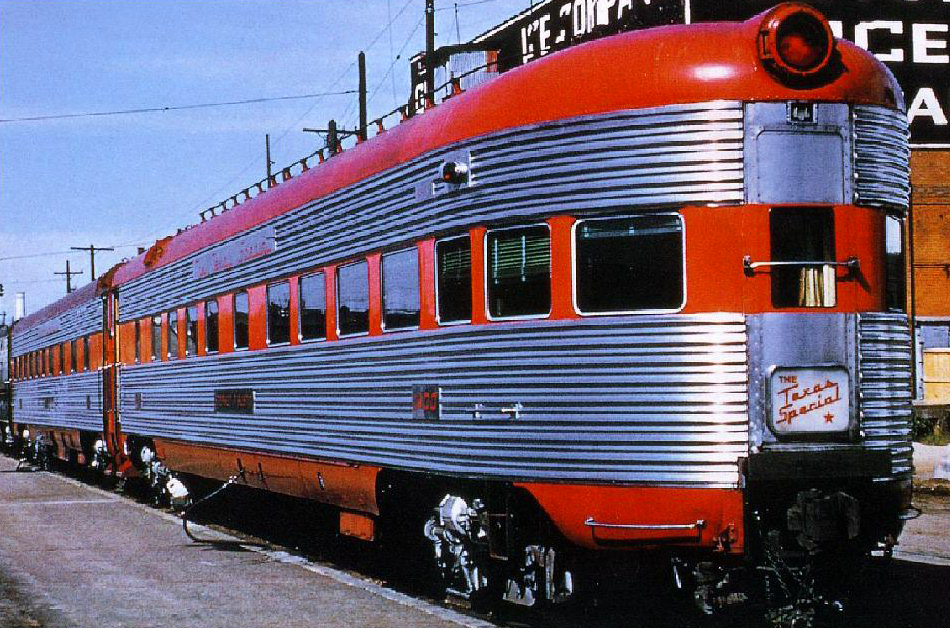 One of the "Texas Special's" handsome lounge observations, manufactured by Pullman-Standard in the late 1940's.
One of the "Texas Special's" handsome lounge observations, manufactured by Pullman-Standard in the late 1940's.Final Years
A typical full consist of the Special between St. Louis and San Antonino included a diner, reclining seat coach service, a coach-lounge-buffet, no less than six sleepers (including B&O and PRR equipment), and finally a lounge observation.
The streamlined version did well until the late 1950s when the Katy’s service levels were deteriorating so badly (due to poor maintenance on both its track and equipment) that trains were running several hours late.
The Frisco, embarrassed by the several service declines, became fed up with the Katy’s antics and discontinued its leg of the Special in 1959. What was left of the Special was discontinued altogether under the Katy until 1965.
Recent Articles
-
Indiana's Dinner Train Rides In Jasper!
Jan 18, 26 01:54 PM
In the rolling hills of southern Indiana, the Spirit of Jasper offers one of those rare attractions that feels equal parts throwback and treat-yourself night out: a classic excursion train paired with… -
New Mexico's Dinner Train Rides
Jan 18, 26 01:37 PM
If your heart is set on clinking glasses while the desert glows at sunset, you can absolutely do that here—just know which operator offers what, and plan accordingly. -
New Hampshire ~ Murder Mystery ~ Dinner Train Rides
Jan 18, 26 01:10 PM
The state's murder mystery trains stand out as a captivating blend of theatrical drama, exquisite dining, and scenic rail travel. -
New York Valentine's Train Rides
Jan 18, 26 12:32 PM
At its best, the Adirondack Railroad delivers exactly what railfans and casual riders alike hope for: vintage coaches, classic depots, rivers and forests right outside the window. -
Washington Valentine's Train Rides
Jan 18, 26 10:50 AM
Whether you’re a dedicated railfan chasing preserved equipment or a couple looking for a memorable night out, CCR&M offers a “small railroad, big experience” vibe—one that shines brightest on its spec… -
Colorado Valentine's Train Rides
Jan 18, 26 10:49 AM
The Royal Gorge Route Railroad is the kind of trip that feels tailor-made for railfans and casual travelers alike, including during Valentine's weekend. -
Georgia Valentine's Train Rides
Jan 18, 26 10:42 AM
f you’ve ridden the SAM Shortline, it’s easy to think of it purely as a modern-day pleasure train—vintage cars, wide South Georgia skies, and a relaxed pace that feels worlds away from interstates and… -
New Jersey ~ Murder Mystery ~ Dinner Train Rides
Jan 17, 26 01:16 PM
There are currently no murder mystery dinner trains available in New Jersey although until 2023 the Cape May Seashore Lines offered this event. Perhaps they will again soon! -
West Virginia Dinner Train Rides In Elkins!
Jan 17, 26 01:08 PM
The D&GV offers the kind of rail experience that feels purpose-built for railfans and casual travelers. -
Virginia Dinner Train Rides In Staunton!
Jan 17, 26 11:55 AM
If you’ve ever wished you could pair a classic scenic train ride with a genuinely satisfying meal—served at your table while the countryside rolls by—the Virginia Scenic Railway was built for you. -
Florida Easter Train Rides
Jan 17, 26 10:23 AM
The cold weather rarely invades Florida and the state nearly always warm and balmy early spring temperatures. Learn more about where you can find Easter-themed train rides across the Sunshine State. -
Ohio Easter Train Rides
Jan 17, 26 10:13 AM
Ohio is home to several museums and excursion trains preserving the state's rich railroading heritage. A few of these locations host Easter-themed train rides each spring. -
Massachusetts Valentine's Train Rides
Jan 17, 26 09:58 AM
The Cape Cod Central Railroad (CCCR) blends classic New England scenery with heritage equipment, narrated sightseeing, and some of the region’s best-known “rails-and-meals” experiences. -
California Valentine's Train Rides
Jan 17, 26 09:53 AM
Operating out of West Sacramento, this excursion railroad has built a calendar that blends scenery with experiences—wine pours, themed parties, dinner-and-entertainment outings, and seasonal specials… -
South Carolina Dinner Train Rides
Jan 16, 26 11:13 PM
There is only location in the Palmetto State offering a true dinner train experience can be found at the South Carolina Railroad Museum. Learn more here. -
Rhode Island Dinner Train Rides
Jan 16, 26 11:01 PM
Despite its small size, Rhode Island is home to one popular dinner train experience where guests can enjoy the breathtaking views of Aquidneck Island. -
Pennsylvania's Thomas The Train Rides
Jan 16, 26 04:13 PM
"A Day Out With Thomas” train rides offer a unique opportunity for children and their families to engage in a magical and memorable experience, setting the stage for a full day of fun and adventure. -
Illinois's Thomas The Train Rides
Jan 16, 26 02:23 PM
In Illinois, the "A Day Out With Thomas" event offers a unique chance for families to immerse themselves in the enchanting world of Thomas and friends, creating memories that last a lifetime. -
New Jersey's Thomas The Train Rides
Jan 16, 26 02:11 PM
Here's a comprehensive guide to what you can expect at Day Out With Thomas events in New Jersey. -
Texas ~ Murder Mystery ~ Dinner Train Rides
Jan 16, 26 01:54 PM
Here’s a comprehensive look into the world of murder mystery dinner trains in Texas. -
Connecticut ~ Murder Mystery ~ Dinner Train Rides
Jan 16, 26 01:26 PM
All aboard the intrigue express! One location in Connecticut typically offers a unique and thrilling experience for both locals and visitors alike, murder mystery trains. -
New Hampshire Dinner Train Rides In N. Conway!
Jan 16, 26 10:47 AM
Tucked into the heart of New Hampshire’s Mount Washington Valley, the Conway Scenic Railroad is one of New England’s most beloved heritage railways -
Oregon Dinner Train Rides Near Mt. Hood!
Jan 16, 26 10:44 AM
The Mt. Hood Railroad is the moving part of that postcard—a century-old short line that began as a working railroad. -
Maryland's - Wine Tasting - Train Rides
Jan 15, 26 02:59 PM
This article delves into the enchanting world of wine tasting train experiences in Maryland, providing a detailed exploration of their offerings, history, and allure. -
Colorado's - Wine Tasting - Train Rides
Jan 15, 26 02:46 PM
To truly savor these local flavors while soaking in the scenic beauty of Colorado, the concept of wine tasting trains has emerged, offering both locals and tourists a luxurious and immersive indulgenc… -
Iowa ~ Wine Tasting ~ Train Rides
Jan 15, 26 02:36 PM
The state not only boasts a burgeoning wine industry but also offers unique experiences such as wine by rail aboard the Boone & Scenic Valley Railroad. -
Georgia's Wine Train Rides In Cordele!
Jan 15, 26 02:26 PM
While the railroad offers a range of themed trips throughout the year, one of its most crowd-pleasing special events is the Wine & Cheese Train—a short, scenic round trip designed to feel like a t… -
Indiana ~ Murder Mystery ~ Dinner Train Rides
Jan 15, 26 02:22 PM
This piece explores the allure of murder mystery trains and why they are becoming a must-try experience for enthusiasts and casual travelers alike. -
Ohio ~ Murder Mystery ~ Dinner Train Rides
Jan 15, 26 02:10 PM
The murder mystery dinner train rides in Ohio provide an immersive experience that combines fine dining, an engaging narrative, and the beauty of Ohio's landscapes. -
Nevada Dinner Train Rides In Ely!
Jan 15, 26 02:01 PM
If you’ve ever wished you could step through a time portal into the hard-working world of a 1900s short line the Nevada Northern Railway in Ely is about as close as it gets. -
Michigan Dinner Train Rides In Owosso!
Jan 15, 26 09:46 AM
The Steam Railroading Institute is best known as the home of Pere Marquette #1225 and even occasionally hosts a dinner train! -
Arizona's - Wine Tasting - Train Rides
Jan 14, 26 02:04 PM
For those who want to experience the charm of Arizona's wine scene while embracing the romance of rail travel, wine tasting train rides offer a memorable journey through the state's picturesque landsc… -
Arkansas's - Wine Tasting - Train Rides
Jan 14, 26 01:57 PM
This article takes you through the experience of wine tasting train rides in Arkansas, highlighting their offerings, routes, and the delightful blend of history, scenery, and flavor that makes them so… -
Tennessee ~ Murder Mystery ~ Dinner Train Rides
Jan 14, 26 01:42 PM
Amidst the rolling hills and scenic landscapes of Tennessee, an exhilarating and interactive experience awaits those with a taste for mystery and intrigue. -
California ~ Murder Mystery ~ Dinner Train Rides
Jan 14, 26 01:26 PM
When it comes to experiencing the allure of crime-solving sprinkled with delicious dining, California's murder mystery dinner train rides have carved a niche for themselves among both locals and touri… -
Illinois ~ Murder Mystery ~ Dinner Train Rides
Jan 14, 26 01:13 PM
Among Illinois's scenic train rides, one of the most unique and captivating experiences is the murder mystery excursion. -
Vermont's - Murder Mystery - Dinner Train Rides
Jan 14, 26 12:57 PM
There are currently murder mystery dinner trains offered in Vermont but until recently the Champlain Valley Dinner Train offered such a trip! -
Massachusetts Dinner Train Rides On Cape Cod!
Jan 14, 26 12:20 PM
The Cape Cod Central Railroad (CCCR) has carved out a special niche by pairing classic New England scenery with old-school hospitality, including some of the best-known dining train experiences in the… -
Maine Dinner Train Rides In Portland!
Jan 14, 26 11:31 AM
While this isn’t generally a “dinner train” railroad in the traditional sense—no multi-course meal served en route—Maine Narrow Gauge does offer several popular ride experiences where food and drink a… -
Kentucky Dinner Train Rides In Bardstown!
Jan 13, 26 01:14 PM
The essence of My Old Kentucky Dinner Train is part restaurant, part scenic excursion, and part living piece of Kentucky rail history. -
Kansas Dinner Train Rides In Abilene!
Jan 13, 26 12:44 PM
If you’re looking for a heritage railroad that feels authentically Kansas—equal parts prairie scenery, small-town history, and hands-on railroading—the Abilene & Smoky Valley Railroad (A&SV) delivers. -
Michigan ~ Murder Mystery ~ Dinner Train Rides
Jan 13, 26 11:24 AM
Among the lesser-known treasures of this state are the intriguing murder mystery dinner train rides—a perfect blend of suspense, dining, and scenic exploration. -
Virginia's - Murder Mystery - Dinner Train Rides
Jan 13, 26 11:11 AM
Among the state's railroad attractions, murder mystery dinner trains stand out as a captivating fusion of theatrical entertainment, fine dining, and scenic travel. -
Arizona Dinner Train Rides At The Grand Canyon!
Jan 13, 26 10:59 AM
While the Grand Canyon Railway does not offer a true, onboard dinner train experience it does offer several upscale options and off-train dining. -
Georgia Dinner Train Rides In Nashville!
Jan 13, 26 10:27 AM
If you’ve ever wished you could slow down, trade traffic for jointed rail, and let a small-town landscape roll by your window while a hot meal is served at your table, the Azalea Sprinter delivers tha… -
Indiana Valentine's Train Rides
Jan 12, 26 04:27 PM
If you’ve ever wished you could step into a time when passenger trains were a Saturday-night treat and a whistle echoing across farm fields meant “adventure,” the Nickel Plate Express delivers that fe… -
Ohio Valentine's Train Rides!
Jan 12, 26 04:20 PM
The Hocking Valley Scenic Railway offers one of the region’s most atmospheric ways to experience the Hocking Hills area: from the rhythmic click of jointed rail to the glow of vintage coaches rolling… -
Wisconsin's - Wine Tasting - Train Rides
Jan 12, 26 03:10 PM
Wisconsin might not be the first state that comes to mind when one thinks of wine, but this scenic region is increasingly gaining recognition for its unique offerings in viticulture. -
California's - Wine Tasting - Train Rides
Jan 12, 26 02:34 PM
This article explores the charm, routes, and offerings of these unique wine tasting trains that traverse California’s picturesque landscapes. -
Wisconsin Scenic Train Rides In North Freedom!
Jan 12, 26 02:20 PM
The Mid-Continent Railway Museum is a living-history museum built around the sights, sounds, and everyday rhythms of small-town and shortline railroading in the early 20th century, what the museum cal…

